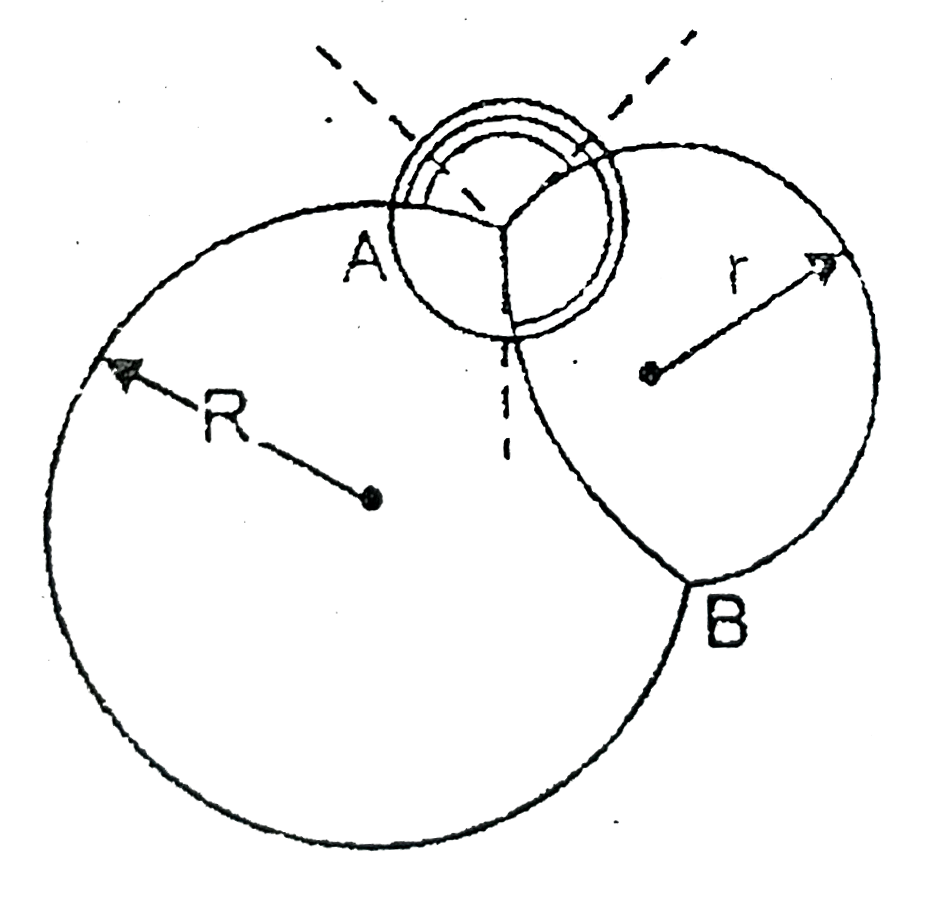A soap bubble A of radius 0.03 m and another bubble B of radius 0.04 m are brought together, so that the combined bubble has a common interface of radius r, then the value of r is
0.24m
0.48m
0.12m
None of these
The correct Answer is:C
To solve the problem of finding the radius r of the common interface of two soap bubbles with given radii, we can follow these steps:
1. Identify the Given Values:
- Radius of bubble A, r1=0.03m
- Radius of bubble B, r2=0.04m
2. Understand the Concept of Excess Pressure:
- The excess pressure inside a soap bubble is given by the formula:
ΔP=4Sr
where S is the surface tension and r is the radius of the bubble.
3. Write the Excess Pressure for Both Bubbles:
- For bubble A:
ΔP1=4Sr1=4S0.03
- For bubble B:
ΔP2=4Sr2=4S0.04
4. Set Up the Pressure Difference Equation:
- When the two bubbles combine, the pressure difference between them can be expressed as:
ΔP′=ΔP1−ΔP2=4Sr
- Therefore, we have:
ΔP1−ΔP2=4Sr
5. Substituting the Excess Pressure Values:
- Substitute the expressions for ΔP1 and ΔP2:
4S0.03−4S0.04=4Sr
6. Simplifying the Equation:
- Factor out 4S:
4S(10.03−10.04)=4Sr
- Cancel 4S from both sides (assuming S≠0):
10.03−10.04=1r
7. Finding a Common Denominator:
- The common denominator for 0.03 and 0.04 is 0.12:
40.12−30.12=1r
- This simplifies to:
10.12=1r
8. Solving for r:
- Therefore, we find:
r=0.12m
Final Answer:
The radius r of the common interface is 0.12m.
---
- Radius of bubble A, r1=0.03m
- Radius of bubble B, r2=0.04m
- The excess pressure inside a soap bubble is given by the formula:
ΔP=4Sr
where S is the surface tension and r is the radius of the bubble.
- For bubble A:
ΔP1=4Sr1=4S0.03
- For bubble B:
ΔP2=4Sr2=4S0.04
- When the two bubbles combine, the pressure difference between them can be expressed as:
ΔP′=ΔP1−ΔP2=4Sr
- Therefore, we have:
ΔP1−ΔP2=4Sr
- Substitute the expressions for ΔP1 and ΔP2:
4S0.03−4S0.04=4Sr
- Factor out 4S:
4S(10.03−10.04)=4Sr
- Cancel 4S from both sides (assuming S≠0):
10.03−10.04=1r
- The common denominator for 0.03 and 0.04 is 0.12:
40.12−30.12=1r
- This simplifies to:
10.12=1r
- Therefore, we find:
r=0.12m
The radius r of the common interface is 0.12m.
Topper's Solved these Questions
- BOOK - MHTCET PREVIOUS YEAR PAPERS AND PRACTICE PAPERSCHAPTER - SURFACE TENSION EXERCISE - Exercise 2 (Miscellaneous Problems)42videos
SURFACE TENSION
- BOOK - MHTCET PREVIOUS YEAR PAPERS AND PRACTICE PAPERSCHAPTER - SURFACE TENSION EXERCISE - MHT CET Corner15videos
SURFACE TENSION
- BOOK - MHTCET PREVIOUS YEAR PAPERS AND PRACTICE PAPERSCHAPTER - SURFACE TENSION EXERCISE - MHT CET Corner15videos
SURFACE TENSION
- BOOK - MHTCET PREVIOUS YEAR PAPERS AND PRACTICE PAPERSCHAPTER - STATIONARY WAVES EXERCISE - MHT CET Corner28videos
STATIONARY WAVES
- BOOK - MHTCET PREVIOUS YEAR PAPERS AND PRACTICE PAPERSCHAPTER - WAVE MOTIONEXERCISE - MHT CET CORNER23videos
WAVE MOTION
Similar Questions
A soap bubble of radius 1 cm expands into a bubble of radius 2 cm. Calculate the increase in surface energy if the surface tension for soap is 25 dyne/cm.
View SolutionA soap bubble of radius 6 cm and another bubble of 8 cm coalesce under isothermal xonditions in vacuum. The radius of the new bubble is
View Solution
Knowledge Check
- Question 1 - Select One
Two soap bubbles one of radius 50 mm and the other of radius 80 mm are brought together so that they have a common interface.
(b) The radius of curvature of this interface attains which shape from smaller bubble towards larger bubble.AConvexBConcaveCPlaneDNone - Question 2 - Select One
Two soap bubbles, one of radius 50mm and the other of radius 80mm, are brought in contact so that they have a common interface. The radius of the curvature of the common interface is
A0.003mB0.133mC1.2mD8.9m - Question 3 - Select One
A soap bubble of radius r is placed on another bubble of radius 2r. The radius of the surface common to both the bubbles is
A2r3B3rC2rDr
If a soap bubble of radius 3 cm coalesce with another soap bubble of radius 4 cm under isothermal conditions the radius of the redultant bubble formed is in cm
View SolutionA soap bubble in vacuum has a radius of 3cm and another soap bubble in vacuum has a radius of 4cm. If the two bubbles coalesce under isothermal conditions then the radius of the new bubble is :
View SolutionA soap buble of radius 1.0 cm is formed inside another soap bubble of radius 2.0 cm . The radius of an another soap bubble which has the same pressure difference as that between the inside of the smaller and outside of large soap bubble , in metres is
View SolutionA soap - bubble with a radius 'r' is placed on another bubbles with a radius R (figure). Angles between the film at the point of contact will be -
 View Solution
View SolutionA soap bubble in vacuum has a radius of 3 cm ad another soap bubble in vacuum has a radius of 4 cm. if the two bubbles coalesce under isothermal condition, then the radius of the new bubble is
View Solution

